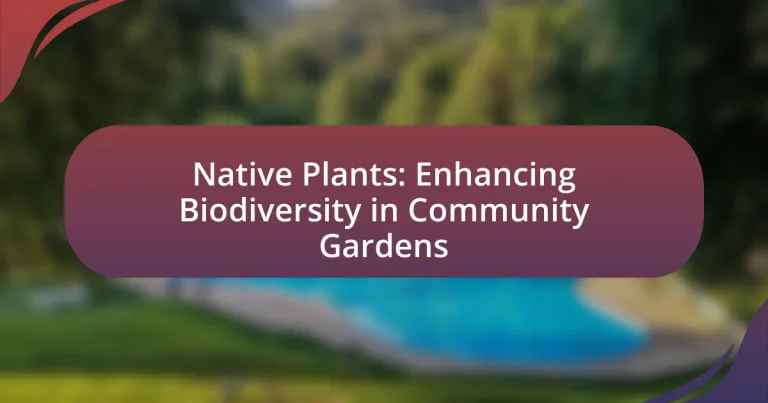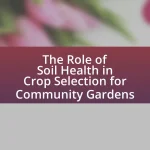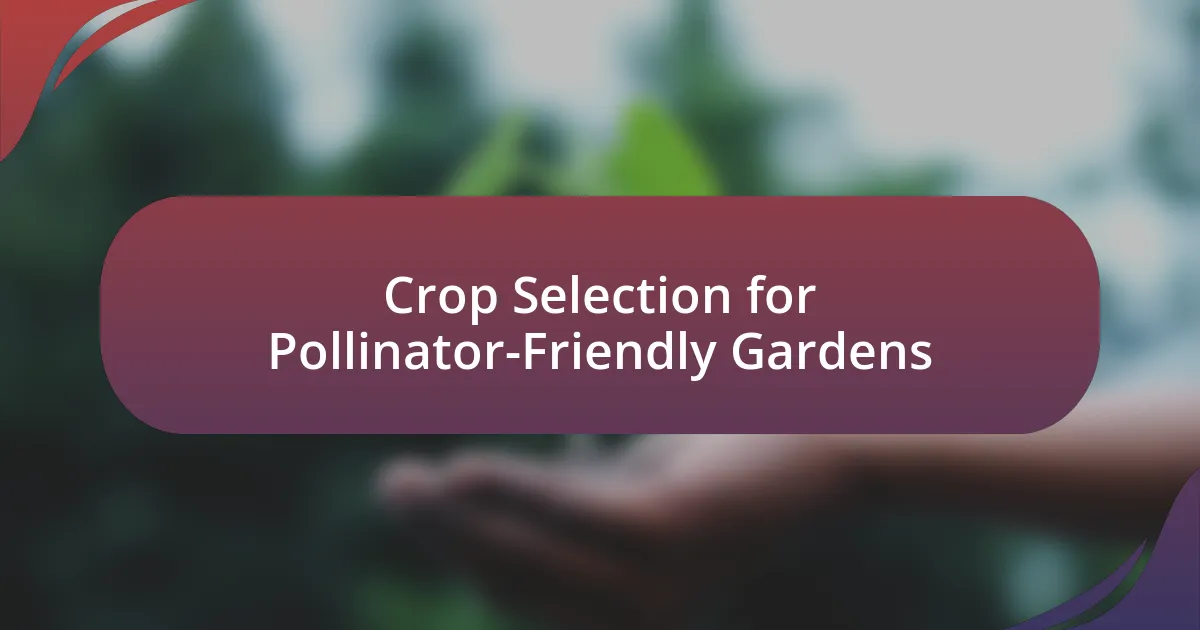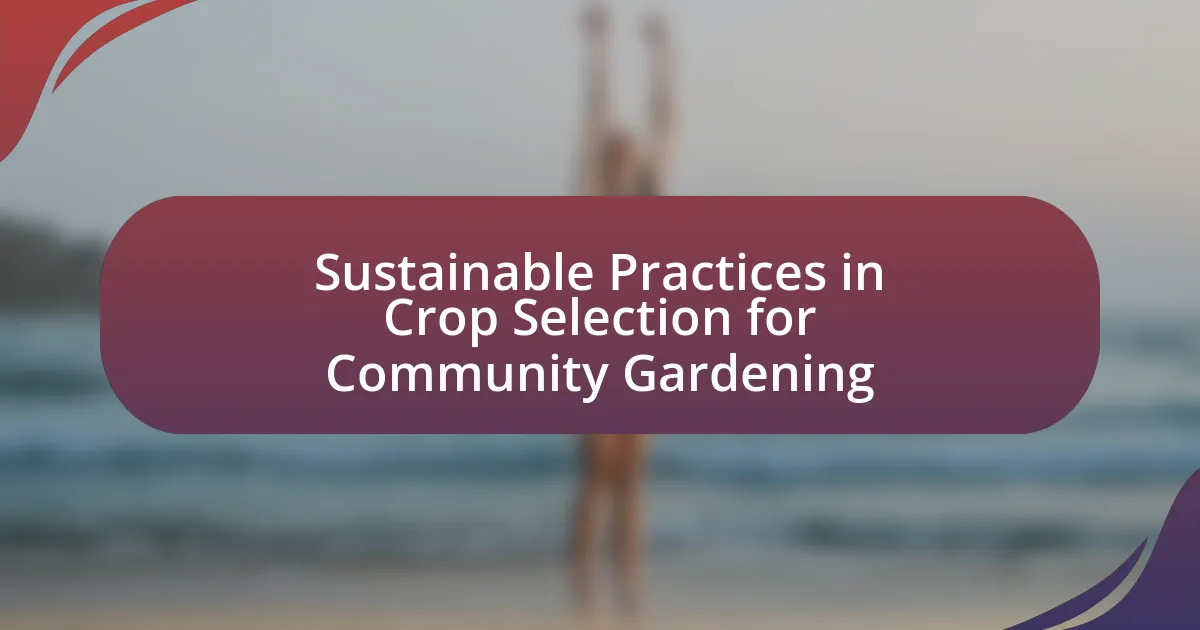Native plants are species that naturally occur in specific regions and play a vital role in enhancing biodiversity within community gardens. This article explores the importance of native plants in supporting local ecosystems, providing habitats and food for wildlife, particularly pollinators. It discusses how native plants contribute to increased biodiversity, improved soil health, and reduced maintenance needs compared to non-native species. Additionally, the article addresses the challenges community gardens face without native plants, including lower pollination rates and increased vulnerability to pests. Practical strategies for incorporating native plants into community gardens, engaging community members, and maintaining these plants sustainably are also outlined, emphasizing their long-term ecological benefits.

What are Native Plants and Why are They Important in Community Gardens?
Native plants are species that naturally occur in a specific region without human introduction. They are important in community gardens because they support local ecosystems by providing habitat and food for native wildlife, including pollinators like bees and butterflies. Research indicates that gardens with native plants can increase biodiversity, improve soil health, and require less water and maintenance compared to non-native species. For example, a study published in the journal “Ecological Applications” found that native plant gardens can attract three times more pollinators than non-native gardens, demonstrating their critical role in enhancing biodiversity and ecological resilience in community settings.
How do native plants contribute to biodiversity?
Native plants contribute to biodiversity by providing essential habitats and food sources for a wide range of wildlife, including insects, birds, and mammals. These plants are adapted to local environmental conditions, which allows them to thrive and support native species that rely on them for survival. For example, studies show that native plants can support up to 50% more wildlife than non-native species, as they offer specific resources that local fauna have evolved to utilize. Additionally, native plants help maintain ecosystem stability and resilience, which is crucial for sustaining diverse biological communities.
What specific roles do native plants play in local ecosystems?
Native plants play crucial roles in local ecosystems by providing habitat, food, and support for native wildlife. They contribute to biodiversity, which enhances ecosystem resilience and stability. For instance, native plants are adapted to local soil and climate conditions, making them more efficient in nutrient cycling and water retention compared to non-native species. Research indicates that areas with a higher diversity of native plants support a greater variety of pollinators, such as bees and butterflies, which are essential for the reproduction of many flowering plants. Additionally, native plants help prevent soil erosion and improve soil health by maintaining the integrity of the root systems.
How do native plants support pollinators and wildlife?
Native plants support pollinators and wildlife by providing essential food sources and habitat. These plants produce nectar and pollen that are crucial for the survival of various pollinators, such as bees, butterflies, and hummingbirds. For instance, studies show that native flowering plants can increase pollinator diversity and abundance, as they have co-evolved with local species, making them more attractive and beneficial to these organisms. Additionally, native plants offer shelter and nesting sites for wildlife, including birds and beneficial insects, thereby enhancing ecosystem stability and resilience. Research indicates that landscapes dominated by native vegetation support higher levels of biodiversity compared to those with non-native species, reinforcing the importance of native plants in sustaining healthy ecosystems.
What challenges do community gardens face without native plants?
Community gardens face significant challenges without native plants, primarily due to reduced biodiversity and increased vulnerability to pests and diseases. Native plants support local ecosystems by providing habitat and food for native pollinators and wildlife, which are essential for maintaining ecological balance. Without these plants, community gardens may experience lower pollination rates, leading to decreased crop yields. Additionally, non-native plants often require more resources, such as water and fertilizers, which can strain local ecosystems and increase maintenance costs. Studies show that gardens incorporating native species can enhance soil health and resilience, making them more sustainable in the long term.
How does the absence of native plants affect soil health?
The absence of native plants negatively impacts soil health by reducing biodiversity and disrupting nutrient cycling. Native plants contribute to soil structure and fertility through their deep root systems, which enhance aeration and water infiltration. Without these plants, soil becomes compacted, leading to decreased microbial activity and lower organic matter content. Research indicates that native plant communities support a higher diversity of soil organisms, which are essential for nutrient cycling and soil fertility. For instance, a study published in the journal “Ecological Applications” by F. A. Smith et al. found that areas with native vegetation had significantly higher soil microbial biomass compared to non-native dominated areas, demonstrating the critical role of native plants in maintaining healthy soil ecosystems.
What impact does it have on pest management in gardens?
Native plants significantly enhance pest management in gardens by promoting biodiversity, which helps establish natural pest control mechanisms. The presence of diverse plant species attracts beneficial insects, such as predatory beetles and parasitic wasps, that prey on common garden pests. Research indicates that gardens with native plants can reduce pest populations by up to 50% compared to those with non-native species, as these native plants provide essential habitats and food sources for beneficial organisms. This ecological balance leads to healthier garden ecosystems and minimizes the need for chemical pesticides.

How Can Community Gardens Incorporate Native Plants Effectively?
Community gardens can effectively incorporate native plants by selecting species that are well-adapted to the local environment and promoting biodiversity. This approach enhances ecosystem resilience, supports local wildlife, and reduces maintenance needs. Research indicates that native plants require less water and fertilizer compared to non-native species, making them more sustainable choices for community gardens. For instance, a study by the University of Florida found that gardens with native plants attracted 50% more pollinators than those with non-natives, demonstrating their ecological benefits. Additionally, involving community members in the selection and planting process fosters a sense of ownership and education about local flora, further enhancing the garden’s impact.
What steps should be taken to select native plants for community gardens?
To select native plants for community gardens, first assess the local climate and soil conditions to ensure compatibility with native species. Next, research native plant species that thrive in the specific region, focusing on those that provide ecological benefits such as attracting pollinators and supporting local wildlife. Additionally, consult local extension services or native plant societies for expert recommendations and resources. Finally, consider the aesthetic and functional needs of the community garden, ensuring a diverse selection that meets both ecological and community goals. This approach is supported by studies indicating that native plants enhance biodiversity and resilience in local ecosystems.
How can gardeners identify suitable native species for their region?
Gardeners can identify suitable native species for their region by consulting local plant databases, extension services, and native plant societies. These resources provide information on plants that are adapted to the specific climate, soil types, and ecological conditions of the area. For example, the USDA Plant Database offers a comprehensive list of native plants categorized by state, which helps gardeners select species that thrive locally. Additionally, engaging with local conservation organizations can provide insights into the best practices for selecting and cultivating native plants that support local wildlife and ecosystems.
What resources are available for sourcing native plants?
Resources for sourcing native plants include local nurseries specializing in native species, botanical gardens that often have plant sales or lists of native plants, and online databases such as the Native Plant Database, which provides information on native plants by region. Additionally, organizations like the National Wildlife Federation and local conservation groups often offer resources and guidance on sourcing native plants. These resources are validated by their focus on promoting biodiversity and ecological health in local environments.
How can community members be engaged in planting native species?
Community members can be engaged in planting native species through organized workshops and hands-on planting events. These activities provide opportunities for education about the ecological benefits of native plants, such as supporting local wildlife and improving soil health. Research indicates that community involvement in such initiatives fosters a sense of ownership and responsibility towards local ecosystems, leading to increased biodiversity in community gardens. For instance, a study by the University of California found that community-led planting projects significantly enhance local flora and fauna diversity, demonstrating the effectiveness of direct engagement strategies.
What educational programs can promote the benefits of native plants?
Educational programs that can promote the benefits of native plants include community workshops, school curricula focused on local ecology, and online courses about sustainable gardening practices. Community workshops often involve hands-on activities that teach participants about the ecological roles of native plants, such as supporting local wildlife and improving soil health. School curricula can integrate lessons on biodiversity and conservation, emphasizing the importance of native species in local ecosystems. Online courses can provide broader access to information on the benefits of native plants, including their role in reducing water usage and maintenance compared to non-native species. These educational initiatives are supported by research indicating that increased awareness and knowledge about native plants lead to greater community engagement in conservation efforts.
How can community events encourage participation in native plant gardening?
Community events can encourage participation in native plant gardening by providing hands-on experiences and education about the benefits of native plants. These events often include workshops, demonstrations, and volunteer opportunities that engage community members directly in gardening activities. For instance, a study by the University of Florida found that community gardening initiatives significantly increased local awareness and involvement in sustainable practices, including native plant gardening. By fostering a sense of community and shared purpose, these events can motivate individuals to adopt native gardening practices, ultimately enhancing local biodiversity.

What are the Long-Term Benefits of Using Native Plants in Community Gardens?
Using native plants in community gardens provides long-term benefits such as enhanced biodiversity, improved ecosystem resilience, and reduced maintenance costs. Native plants support local wildlife, including pollinators and beneficial insects, which contributes to a balanced ecosystem. Research indicates that gardens with native species can increase local biodiversity by up to 50%, fostering a healthier environment. Additionally, native plants are adapted to local soil and climate conditions, requiring less water and fewer chemical inputs, which leads to lower maintenance costs over time. This adaptability also enhances the garden’s resilience to pests and diseases, ensuring sustainability in the long run.
How do native plants enhance the resilience of community gardens?
Native plants enhance the resilience of community gardens by improving soil health, increasing biodiversity, and providing habitat for beneficial wildlife. These plants are adapted to local environmental conditions, which allows them to thrive with minimal maintenance and resources. Research indicates that native plants can reduce the need for irrigation by up to 50% compared to non-native species, as they are better suited to local rainfall patterns. Additionally, native plants attract pollinators and other beneficial insects, which can lead to improved crop yields and pest control. Studies show that gardens with a higher diversity of native species exhibit greater resistance to pests and diseases, thereby increasing overall garden resilience.
What are the ecological benefits of increased biodiversity?
Increased biodiversity provides essential ecological benefits, including enhanced ecosystem resilience, improved soil health, and greater pollination efficiency. Ecosystem resilience is strengthened as diverse species can better withstand environmental changes and disturbances, reducing the risk of ecosystem collapse. For instance, studies show that ecosystems with higher species diversity are more productive and stable, as they can utilize resources more efficiently. Improved soil health results from a variety of plant species contributing to nutrient cycling and organic matter, which enhances soil structure and fertility. Additionally, greater biodiversity leads to more effective pollination, as different pollinators are attracted to various plant species, ensuring successful reproduction and food production. Research indicates that diverse plant communities can support a wider range of pollinators, which is crucial for agricultural productivity and food security.
How do native plants contribute to climate adaptation in urban areas?
Native plants contribute to climate adaptation in urban areas by enhancing biodiversity, improving soil health, and increasing resilience to extreme weather events. These plants are well-suited to local climates and soil conditions, which allows them to thrive with minimal water and maintenance, reducing the urban heat island effect. Research indicates that urban areas with diverse native plant species can better manage stormwater runoff, as these plants improve infiltration and reduce flooding risks. Additionally, native plants provide habitat for pollinators and other wildlife, which supports ecosystem stability and resilience in the face of climate change.
What are some best practices for maintaining native plants in community gardens?
Best practices for maintaining native plants in community gardens include selecting appropriate species, ensuring proper soil health, implementing effective watering techniques, and managing pests organically. Selecting native species that are well-adapted to the local climate and soil conditions enhances resilience and reduces maintenance needs. Maintaining soil health through composting and mulching supports plant growth and biodiversity. Effective watering techniques, such as drip irrigation, minimize water waste and ensure consistent moisture levels. Organic pest management strategies, like introducing beneficial insects and using natural repellents, help protect native plants without harming the ecosystem. These practices collectively contribute to the sustainability and health of community gardens, fostering biodiversity and ecological balance.
How can gardeners ensure the health and sustainability of native plants?
Gardeners can ensure the health and sustainability of native plants by implementing practices such as selecting appropriate species for their local environment, providing adequate water and nutrients, and controlling invasive species. Selecting native plants that are well-adapted to local soil, climate, and wildlife conditions enhances their resilience and reduces maintenance needs. Providing consistent watering, especially during dry spells, and using organic fertilizers can promote healthy growth. Additionally, actively managing invasive species through removal and prevention strategies protects native plants from competition and disease. Research indicates that native plants support local ecosystems by attracting pollinators and other beneficial organisms, thereby enhancing biodiversity in community gardens.
What common issues should gardeners be aware of when caring for native plants?
Common issues gardeners should be aware of when caring for native plants include improper soil conditions, inadequate water management, and pest infestations. Native plants often require specific soil types to thrive; for instance, many prefer well-drained soils rich in organic matter. Additionally, gardeners must monitor water levels, as both overwatering and underwatering can stress these plants, leading to poor growth or death. Pest infestations can also pose a threat, as native plants may attract specific insects that can damage foliage or roots. Understanding these factors is crucial for successful cultivation and maintenance of native plants in community gardens.
What practical tips can community gardeners follow to maximize the benefits of native plants?
Community gardeners can maximize the benefits of native plants by selecting species that are well-adapted to the local environment, which enhances biodiversity and supports local wildlife. Choosing native plants that require less water and maintenance reduces resource consumption and promotes sustainability. Additionally, planting in diverse layers—such as ground covers, shrubs, and trees—creates habitats for various species, increasing ecological resilience. Research shows that native plants attract pollinators, with studies indicating that gardens with native flora can support up to 50% more pollinator species compared to non-native gardens. Implementing these strategies not only fosters a thriving ecosystem but also contributes to the overall health of the community garden.





